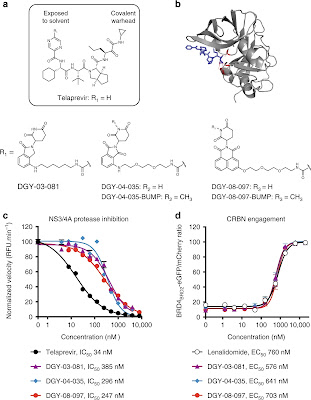Mei Zeng, Yuan Xiong, Nozhat Safaee, Radoslaw P. Nowak, Katherine A. Donovan, Christine J. Yuan, Behnam Nabet, Thomas W. Gero, Frederic Feru, Lianbo Li, Sudershan Gondi, Lincoln J. Ombelets, Chunshan Quan, Pasi A. Jänne, Milka Kostic, David A. Scott, Kenneth D. Westover, Eric S. Fischer Nathanael S. Gray
Cell Chemical Biology, 2019
KRAS is the most frequently mutated oncogene found in pancreatic, colorectal, and lung cancers. Although it has been challenging to identify targeted therapies for cancers harboring KRAS mutations, KRAS G12C can be targeted by small-molecule inhibitors that form covalent bonds with cysteine 12 (C12). Here, we designed a library of C12-directed covalent degrader molecules (PROTACs) and subjected them to a rigorous evaluation process to rapidly identify a lead compound. Our lead degrader successfully engaged CRBN in cells, bound KRAS G12C in vitro, induced CRBN/KRAS G12C dimerization, and degraded GFP-KRAS G12C in reporter cells in a CRBN-dependent manner. However, it failed to degrade endogenous KRAS G12C in pancreatic and lung cancer cells. Our data suggest that inability of the lead degrader to effectively poly-ubiquitinate endogenous KRAS G12C underlies the lack of activity. We discuss challenges for achieving targeted KRAS G12C degradation and proposed several possible solutions which may lead to efficient degradation of endogenous KRAS G12C.

























